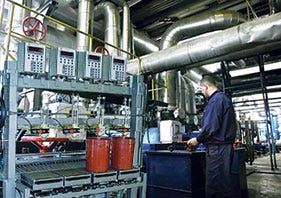Uninterruptible power systems keep fillers running
March 11, 2015
Crandall Intl, Inc. (www.crandall.com) manufactures precision packaging machinery for use in the food, chemical and petroleum industries. Its customers' products include lube oil, paints, industrial chemicals, food flavorings, antifreeze and other liquids. The company's highly accurate, gravimetric filling machines can fill containers from as small as 500 mL up to a 55-gal (220-L) drum or keg.
The filling machines' accuracy must be assured at all times to meet customer demands, so the machines incorporate advanced microprocessor-based digital electronics connected to a precision digital scale to ensure that the liquids are filled to the exact amount required.
Crandall Intl. Model DN filling machines feature one to four filling nozzles, use digital scales for weight sensing and are capable of filling up to 1,400 containers/hr. The gravimetric fillers can accurately fill a wide range of liquid and semi-liquid products, and sub-surface models can fill both foaming and nonfoaming products. Fast-fill/slow-fill commands are included on the machine. The standard model uses a preset container weight or tare. This is maintained as the tare for the entire fill, or until the operator tares another empty container. Automatic tare for each container is available as an option.
For more information about fillers, visit Packaging Digest's FILL, F/F/S TECHNOLOGY CHANNEL at www.packagingdigest.com/ info/formfill/
In either case, the containers are accurately filled to a net weight. All DN models rely on an electronic load cell with a digital indicator that features a meter containing a microprocessor-based programmable-logic controller board. This PLC board, which is the brain of the system's weighing mechanism, is very sensitive and requires a steady voltage source.
Crandall machines are sold worldwide. Due to the machines' electronics, extreme utility power problems experienced in many third-world countries were rendering the machines unreliable. Several years ago, when Crandall began selling the new DN models to international customers in locations in Africa, South Asia and Latin America, it started to experience failures of the scale controller in about three out of every 10 systems shipped. Customers were experiencing malfunctions due to failure of the electronic scale controllers. Units that were operating in the U.S., Canada, Saudi Arabia and other more developed countries did not experience these failures.

Fillers shipped to third-world countries can experience problems caused by bad power supplies.
These failures meant lost production for the customer that proved very costly. Replacing the system's controller board costs approximately $2,000 to Crandall if the system is still under warranty, or to the customer if it is out of warranty. However, the real cost to customers was when they had to stop production while the machine was down, or resort to manually filling containers, which was much slower and less accurate than filling with the machines. From the time trouble began to the time that the diagnosis was made and the replacement part was shipped, cleared through local customs and properly reinserted, the customer could be without use of the filling machine for as long as one to two weeks.
Crandall Intl. sent the malfunctioning boards to Rice Lake Weighing Systems (www.ricelake.com), the manufacturer of the scale controllers, which determined that the failures were a result of voltage drops and spikes. Once it was clear that the problem was the power, Crandall went to its battery supplier and asked them if they could help, because they dealt with computer power protection. They directed the company to a line of rugged, online, uninterruptible power systems (UPS) from Falcon Electric, Inc. (www.falconups.com).
They pointed out that Falcon Electric offers professional-grade, double-conversion, online UPS, and that this type of UPS is the only type that will proactively correct an under- or over-voltage problem automatically. Falcon advised against using a cheaper, more rudimentary type of UPS with an off-line or line-interactive design. These types of systems could help, but only by reacting to the under- or over-voltage condition. After 4 to 30 msec, the off-line and line-interactive UPS changes winding taps on an internal transformer in an attempt to grossly regulate (±8 to 12 percent) the polluted utility power. These designs pass many power-related problems, including high-voltage transients, frequency shifts and short-duration voltage dropouts, directly through to the meter's sensitive electronics.
An online UPS creates new, clean power on a continuous basis, offering a much higher level of voltage regulation (±2 to 3 percent) and protection. In effect, the online UPS creates an "electronic firewall" between the incoming utility power and the sensitive equipment. This is accomplished inside the UPS in several tiers of circuits.
First, the incoming alternating-current utility voltage is passed through a surge-protected rectifier stage, where it is converted to direct current and is heavily filtered by large capacitors. This tier removes line noise, high-voltage transients, harmonic distortion and all 50/60 htz frequency-related problems. The capacitors also act as an energy-storage reservoir giving the UPS the ability to ride through momentary power interruptions. The battery is also connected to this tier and takes over as the energy source in the event of a utility loss. This makes the transition between utility and battery power seamless, without an interruption.
Since Crandall has been shipping Falcon Electric's SG Series online UPS with its systems, or recommending a true, online UPS, the power problems have vanished. Its more-sophisticated systems cost from $30,000 to $50,000, and customers rely on these systems to keep their production line moving; in essence, to keep them in business. The Falcon Electric UPS shipped with each unit provides peace of mind that power problems will not bring the filling systems down.
More information is available:
Crandall Intl, Inc., 716/876-0402. www.crandall.com.
Falcon Electric, Inc., 800/842-6940. www.falconups.com.
Rice Lake Weighing Systems, 800/472-6703. www.ricelake.com.
You May Also Like


